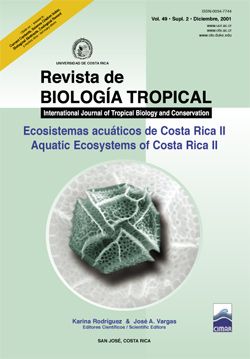Abstract
This is the first record of the dinoflagellate Lingulodinium polyedrum in a red tide bloom in the North Pacific coast of Costa Rica. The sample was collected on April 2000 at Culebra Bay, Gulf of Papagayo, from a patch of aproximatly 2000 m2, which produced a red discoloration of the water and a peculiar strong odor. This species produces spherical hypnocysts that may remain for decades when dark or anoxic conditions are present; L. polyedrum had been associated with the production of paralyzing toxins such as saxitoxins and yessotoxins. A second smaller patch was observed close Panama beach, into the bay, where we found seven puffer fish (Diodontidae) and two lobsters dead in the sand. It is important to develop a monitoring program to identify seasonal behavior of this species and ameliorate its impact on coastal human communities.References
Anderson, D.M., C.D. Taylor & E.V. Armbrust. 1987. The effects of darkness and anaerobiosis on dinoflagellate cyst germination. Limnol. Oceanogr. 32(2): 340-351.
Anderson, D.M. & A.W. White. 1992. Toxic dinoflagellates and marine mammal mortalities. Tech. Report WHOI - 89-36. Woods Hole Oceanographic Institution. pp. 1-65.
Balech, E. 1988. Los Dinoflagelados del Atlántico Sudoccidental. Publicaciones Especiales, Instituto Español de Oceanografía. Ministerio de Agricultura Pesca y Alimentación. 310 pp.
Belin, C., B. Bellaeff, B. Raffin, M. Rabla & F. Ibañez. 1995. Phytoplankton time series data of the french phytoplankton monitoring network: toxic and dominat species. p. 771-776. In: P. Lassus, G. Arzul, E. Errad-Le Denn, P. Gentien & C. Marcaillou-Le Vaut (eds). Harmful Marine Algal Blooms. Lavoisier. New York.
Bruno, M., P.M.B. Gucci, E. Prerdominici, A. Isoppolo & L. Volterra. 1990. Presence of saxitoxin in toxic extract from Gonyaulux polyedra . Toxicon 28: 1113-1116.
Cortés-Altamirano, R. & R. Soria-Luna. 1998. Lista mundial de microalgas responsables de florecimientos, mareas rojas y tóxicas. p. 141-153. In: R. Cortés-Altamirano (Ed.). Las Mareas Rojas. ATG Editor S.A. D.F., México.
Estrada, M. 1986. Mareas Rojas. Inf. Tec. Inst. Pesq. Barcelona. 132: 16 p. Gocke, K., J. Cortés & C. Villalobos. 1990. Effects of red tides on oxygen concentration and distribution in the Golfo of Nicoya, Costa Rica. Rev. Biol. Trop. 38(2b): 401-407.
Guzmán, H., J. Cortés, R. Richmond & P. Glynn. 1990. Coral mortality associated with dinoflagellate blooms in the eastern Pacific (Costa Rica and Panama). Mar. Ecol. Prog. Ser. 60: 299-303.
Hargraves, P.E. & R. Víquez. 1981. The dinoflagellate red tide in Golfo de Nicoya, Costa Rica. Rev. Biol. Trop. 29: 31-38.
Hargraves, P.E. & R. Víquez. 1985. Spatial and temporal distribution of phytoplankton in the Gulf of Nicoya, Costa Rica. Bull. Mar. Sci. 37: 577-585.
Jiménez, C. 1998. Arrecifes y comunidades coralinas de Bahía Culebra, Pacífico Norte de Costa Rica, Golfo de Papagayo. M.Sc. Tesis, Universidad de Costa Rica. 218 p.
Kudela, R. M. & W. P. Cochlan. 2000. Nitrogen and carbon uptake kinetics and the influence of irradiance for a red tide bloom off southern California. Aquat. Microb. Ecol. 21: 31-47.
Lewis, J., P. Tett & J.D. Dodge. 1985. The cyst-theca cycle of Gonyaulax polyedra (Lingulodinium machaerophorum) in Creran, a ScottishWest coast sea-loch. p: 85-90. In: D.M. Anderson, C.D. White & C. Baden (eds). Toxic dinoflagellates. Elsevier. New York.
Mata, L., G. Abarca, L. Marranghello & R. Víquez. 1990. Intoxicación paralítica por mariscos (IPM) por Spondylus calcifer contaminado con Pyrodinium bahamense, Costa Rica, 1989-1990. Rev. Biol. Trop. 38(1): 129-136.
Martsuoka K. & Y. Fukuyo. 1995. Taxonomy of cysts. p. 381-401. In: Hallegraeff, D.M. Anderson and Cembella (eds). Manual on Harmful Marine Microalgae. UNESCO Manuals and Guides 33.
Palma, A. S., A. A. Ferreira, M. A. Sampayo, M. T. Moita1 & T. Rosa1. 2000. On a Lingulodinium polyedra bloom in the Setúbal Bay, Portugal. MATINET (en línea) http://www.utas.edu.au/docs/plant_science/HAB 2000/index.html (Fecha de consulta 13 junio, 2000).
Smayda, T. & Y. Shimizu. 1993. Toxic Phytoplankton Blooms in the Sea. Proceedings of the Fifth International Conference on Toxic Marine Phytoplankton, Newport, Rhode Island, 28 October-1 November 1991. 952 p.
Steindinger, K.A. 1993. Some taxonomic and biologic aspects of toxic dinoflagellates. p. 1-28. In: Falconer, I.R. (ed.). Algal Toxins in Seafood and Drinking Water. Academic, London, UK.
Tester, P.A., J.T. Turner & D. Shea. 2000. Vectorial transport of toxins from the dinoflagellate Gymnodinium breve through copepods to fish. J. Plank. Res. 22: 47-61.
Thomas W.H. & C.H. Gibson. 1990. Quantified smallscale turbulence inhibits a red tide dinoflagellate, Gonyaulax polyedra Stein. Deep Sea Res. 17(10): 1583-1593.
Víquez R. & P.E. Hargraves. 1995. Annual cycle of red tide dinoflagellates in the Gulf of Nicoya. Bull. Mar. Sc. 57(2): 467-475.
Yasumoto T. & M. Satake. 1998. New toxins and their toxicological evaluation. p. 381-401. In: Reguera, B., J. Blanco, M.L. Fernández & T. Wyatt (eds). Harmful Algae. Xunta de Galicia, IOC, UNESCO.

This work is licensed under a Creative Commons Attribution 4.0 International License.
Copyright (c) 2001 Revista de Biología Tropical

